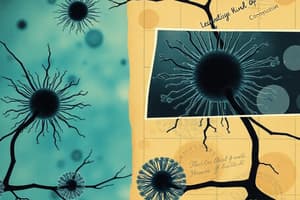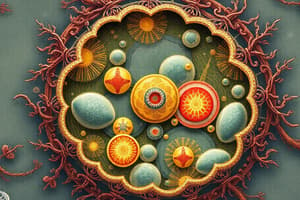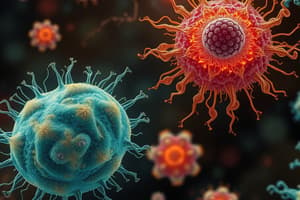Podcast
Questions and Answers
What was a likely characteristic of the first primitive eukaryotes?
What was a likely characteristic of the first primitive eukaryotes?
- They had specialized functions.
- They were multicellular organisms.
- They were single-celled and independent. (correct)
- They formed colonies immediately.
How do eukaryotic flagella differ from bacterial flagella?
How do eukaryotic flagella differ from bacterial flagella?
- Bacterial flagella have a 9 + 2 arrangement.
- Eukaryotic flagella are more flexible.
- Bacterial flagella are typically longer.
- Eukaryotic flagella are about ten times thicker. (correct)
What is the arrangement of microtubules in eukaryotic flagella known as?
What is the arrangement of microtubules in eukaryotic flagella known as?
- 8 + 2 arrangement
- 9 + 2 arrangement (correct)
- 9 + 1 arrangement
- 7 + 3 arrangement
Which of the following statements accurately describes cilia?
Which of the following statements accurately describes cilia?
What evolutionary change occurred as cells within colonies specialized?
What evolutionary change occurred as cells within colonies specialized?
Which of these can be a characteristic of a filamentous fungi colony?
Which of these can be a characteristic of a filamentous fungi colony?
What is the primary function of vegetative hyphae in fungi?
What is the primary function of vegetative hyphae in fungi?
How does the presence of septa in hyphae affect the fungal colony?
How does the presence of septa in hyphae affect the fungal colony?
What is the main role of sporangiospores in fungal reproduction?
What is the main role of sporangiospores in fungal reproduction?
Which of these factors is NOT essential for the successful completion of a helminth's life cycle?
Which of these factors is NOT essential for the successful completion of a helminth's life cycle?
What is the primary mode of reproduction in most protozoa?
What is the primary mode of reproduction in most protozoa?
Which of the following is NOT associated with the trophozoite stage of protozoan life cycle?
Which of the following is NOT associated with the trophozoite stage of protozoan life cycle?
Which of these correctly describes the term 'cyst' in relation to protozoa?
Which of these correctly describes the term 'cyst' in relation to protozoa?
What is the primary limiting factor for the growth and survival of protozoa?
What is the primary limiting factor for the growth and survival of protozoa?
How do tapeworms (cestodes) differ from flukes (trematodes) in terms of their body structure?
How do tapeworms (cestodes) differ from flukes (trematodes) in terms of their body structure?
Which of these is NOT a characteristic of roundworms (nematodes)?
Which of these is NOT a characteristic of roundworms (nematodes)?
What is the primary reason for the large number of eggs laid by parasitic worms (helminths)?
What is the primary reason for the large number of eggs laid by parasitic worms (helminths)?
What is a key distinction between the intermediate host and the definitive host in a helminth's life cycle?
What is a key distinction between the intermediate host and the definitive host in a helminth's life cycle?
Which of the following describes the life cycle of a pinworm (Enterobius vermicularis)?
Which of the following describes the life cycle of a pinworm (Enterobius vermicularis)?
What is the most significant factor contributing to the high incidence of helminth infections in tropical areas?
What is the most significant factor contributing to the high incidence of helminth infections in tropical areas?
Which of these statements is TRUE about the distribution of helminth infections?
Which of these statements is TRUE about the distribution of helminth infections?
What is the primary function of the glycocalyx in cells?
What is the primary function of the glycocalyx in cells?
Which of the following best describes the composition of fungal cell walls?
Which of the following best describes the composition of fungal cell walls?
What is the purpose of the rough endoplasmic reticulum (RER)?
What is the purpose of the rough endoplasmic reticulum (RER)?
Which organelle is primarily responsible for energy production in the cell?
Which organelle is primarily responsible for energy production in the cell?
Which type of fungal cell form is characterized by long, threadlike structures?
Which type of fungal cell form is characterized by long, threadlike structures?
What role do lysosomes play in cellular function?
What role do lysosomes play in cellular function?
Which cellular structure is involved in the modification and packaging of proteins?
Which cellular structure is involved in the modification and packaging of proteins?
What characteristic is unique to mitochondria?
What characteristic is unique to mitochondria?
What type of nutrition do fungi exhibit?
What type of nutrition do fungi exhibit?
What structures are involved in the intracellular transport of materials?
What structures are involved in the intracellular transport of materials?
Which of the following is NOT a type of ribosome found in cells?
Which of the following is NOT a type of ribosome found in cells?
Which process allows chloroplasts to convert light energy into chemical energy?
Which process allows chloroplasts to convert light energy into chemical energy?
What is a major agricultural impact of fungi?
What is a major agricultural impact of fungi?
Flashcards
Primitive Eukaryotes
Primitive Eukaryotes
Early eukaryotes that were likely single-celled and independent.
Cell Specialization
Cell Specialization
Process where cells in a colony take on specific functions.
Eukaryotic Flagella
Eukaryotic Flagella
Thicker, complex structures for movement, covered by cell membrane extensions.
9 + 2 Arrangement
9 + 2 Arrangement
Signup and view all the flashcards
Eukaryotic Cilia
Eukaryotic Cilia
Signup and view all the flashcards
Glycocalyx
Glycocalyx
Signup and view all the flashcards
Cell Wall
Cell Wall
Signup and view all the flashcards
Cell Membrane
Cell Membrane
Signup and view all the flashcards
Nucleus
Nucleus
Signup and view all the flashcards
Endoplasmic Reticulum
Endoplasmic Reticulum
Signup and view all the flashcards
Golgi Apparatus
Golgi Apparatus
Signup and view all the flashcards
Lysosomes
Lysosomes
Signup and view all the flashcards
Vacuoles
Vacuoles
Signup and view all the flashcards
Mitochondria
Mitochondria
Signup and view all the flashcards
Chloroplasts
Chloroplasts
Signup and view all the flashcards
Ribosomes
Ribosomes
Signup and view all the flashcards
Cytoskeleton
Cytoskeleton
Signup and view all the flashcards
Yeasts
Yeasts
Signup and view all the flashcards
Fungal Diseases
Fungal Diseases
Signup and view all the flashcards
Fungal Nutrition
Fungal Nutrition
Signup and view all the flashcards
Mycelium
Mycelium
Signup and view all the flashcards
Septa
Septa
Signup and view all the flashcards
Nonseptate Hyphae
Nonseptate Hyphae
Signup and view all the flashcards
Vegetative Hyphae
Vegetative Hyphae
Signup and view all the flashcards
Reproductive Hyphae
Reproductive Hyphae
Signup and view all the flashcards
Spores
Spores
Signup and view all the flashcards
Sporangiospores
Sporangiospores
Signup and view all the flashcards
Conidiospores
Conidiospores
Signup and view all the flashcards
Trophozoite
Trophozoite
Signup and view all the flashcards
Cyst
Cyst
Signup and view all the flashcards
Helminths
Helminths
Signup and view all the flashcards
Flatworms
Flatworms
Signup and view all the flashcards
Nematodes
Nematodes
Signup and view all the flashcards
Pinworm Life Cycle
Pinworm Life Cycle
Signup and view all the flashcards
Ciliates
Ciliates
Signup and view all the flashcards
Study Notes
Overview of the Eukaryotic Cell
- First primitive eukaryotes were likely single-celled and independent
- Cells aggregated over time, forming colonies
- Cells within colonies specialized to perform specific functions
- Complex multicellular organisms evolved as individual cells lost the ability to survive separately from the intact colony
External Structures
- Flagella: Different from bacterial flagella, about ten times thicker, structurally more complex, covered by a cell membrane extension, and contain regularly spaced microtubules.
- Cilia: Similar to flagella in structure, but smaller and more numerous, found in protozoa and certain animal cells; microtubules are regularly spaced along the entire length.
Microtubules in Flagella
- Regularly spaced microtubules extend along the entire length
- Nine pairs of microtubules surround a single pair (9+2 arrangement)
- Also present in cilia
The Glycocalyx
- An outermost layer that directly contacts the environment
- Composed of polysaccharides
- Appears as a network of fibers
Boundary Structures: Cell Wall
- Protozoa and helminths do not have cell walls
- Fungal cell walls provide rigidity and shape
- Chemical composition differs from bacterial and archaeal cell walls
- Thick inner layer of polysaccharide fibers (chitin or cellulose)
- Thin outer layer of mixed glycans
Boundary Structures: The Cell Membrane
- Typical bilayer of phospholipids with embedded protein molecules
- Contains sterols for membrane rigidity and stability
- Important for cells lacking cell walls
- Eukaryotic cytoplasmic membranes function similarly to bacterial and archaeal membranes, acting as selectively permeable barriers.
Internal Structures: The Nucleus
- Most prominent eukaryotic organelle
- Separated from the cytoplasm by the nuclear envelope (double membrane)
- Perforated with pores for macromolecule migration
- Includes the nucleolus (ribosomal RNA synthesis), and chromatin (DNA and histone proteins)
Internal Structures: Endoplasmic Reticulum
- Series of membrane tunnels for transport and storage
- Rough ER: Ribosomes attached, responsible for protein transport from nucleus to cytoplasm/exterior
- Smooth ER: Tubular, no ribosomes, involved in nutrient processing and synthesis/storage of non-protein macromolecules (lipids)
Internal Structures: Golgi Apparatus
- Flattened disc-shaped sacs (cisternae) associated with the endoplasmic reticulum
- Modifies and processes proteins, adding polysaccharides and lipids
- Packages modified proteins into vesicles for transport to other parts of the cell or exterior
Internal Structures: Vesicles (Lysosomes)
- Bud off the Golgi apparatus
- Contain enzymes for intracellular digestion of particles
- Provide protection against invading organisms
Internal Structures: Mitochondria
- Generate energy for the cell
- Composed of an outer and inner membrane (cristae)
- Extract chemical energy from nutrients and store it as ATP
- Contain circular DNA and 70S ribosomes (similar to bacteria)
- Independent division
Internal Structures: Chloroplasts
- Found in algae and plants
- Convert light energy to chemical energy through photosynthesis
- Produce oxygen
- Possess their own DNA and ribosomes
- Larger, more varied in shape, and possess pigments than mitochondria
Internal Structures: Ribosomes
- Scattered, or attached to the rough ER
- Involved in protein synthesis
- Composed of large and small subunits of ribonucleoprotein
The Cytoskeleton
- Three major components: actin filaments, intermediate filaments, microtubules
- Roles include anchoring organelles, moving materials, and enabling shape changes/movement
Fungal Cells
- Two basic forms: yeasts (round/oval) and hyphae (long/thread-like)
- Yeast reproduce by budding; hyphae by fragmentation/spores
- Asexual Spores: Sporangiospores (in a sac) and conidiospores (not in a sac)
Fungal Disease
- 300 species cause human disease (community-acquired, hospital-associated, opportunistic)
Studying That Suits You
Use AI to generate personalized quizzes and flashcards to suit your learning preferences.




